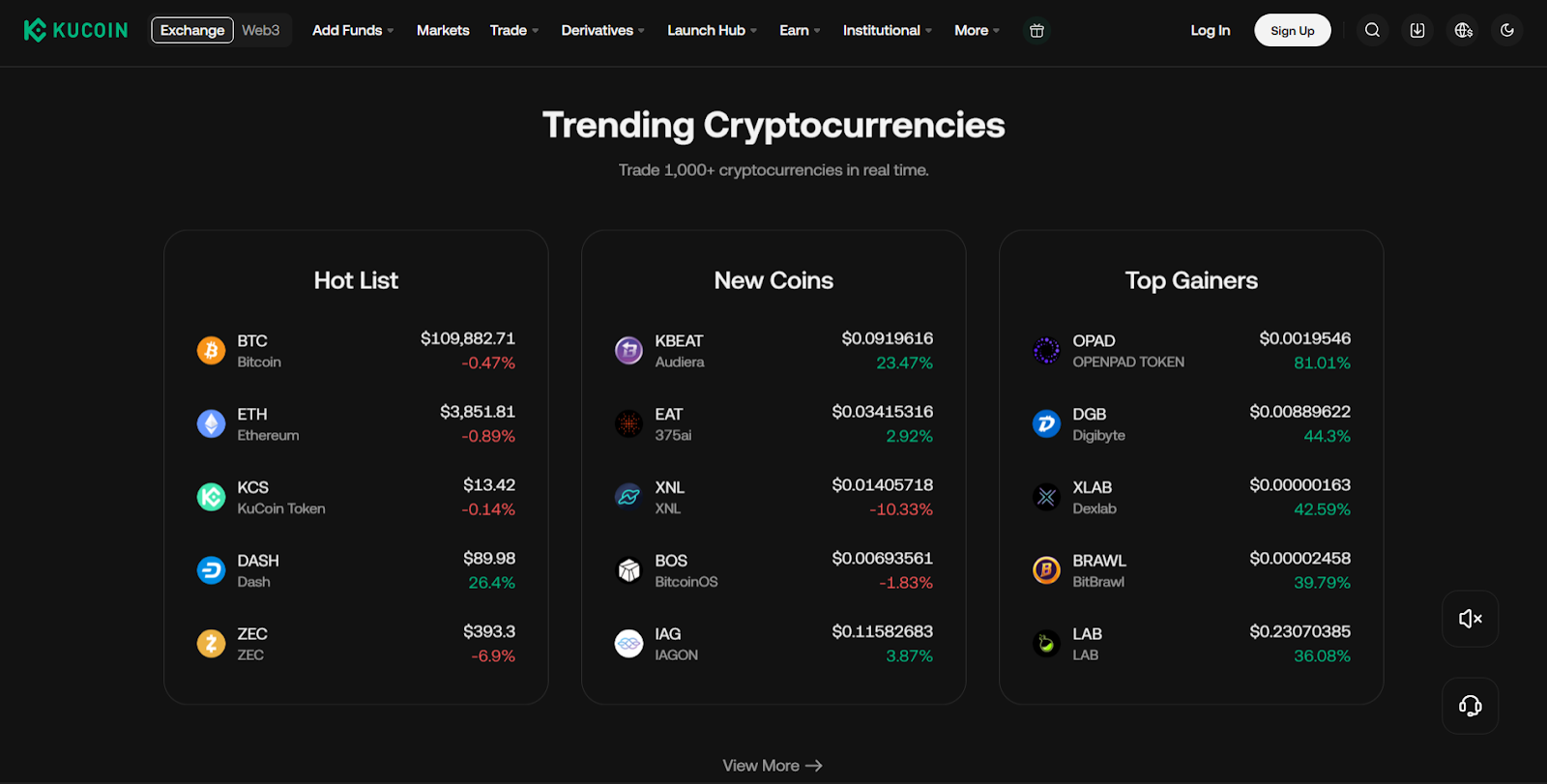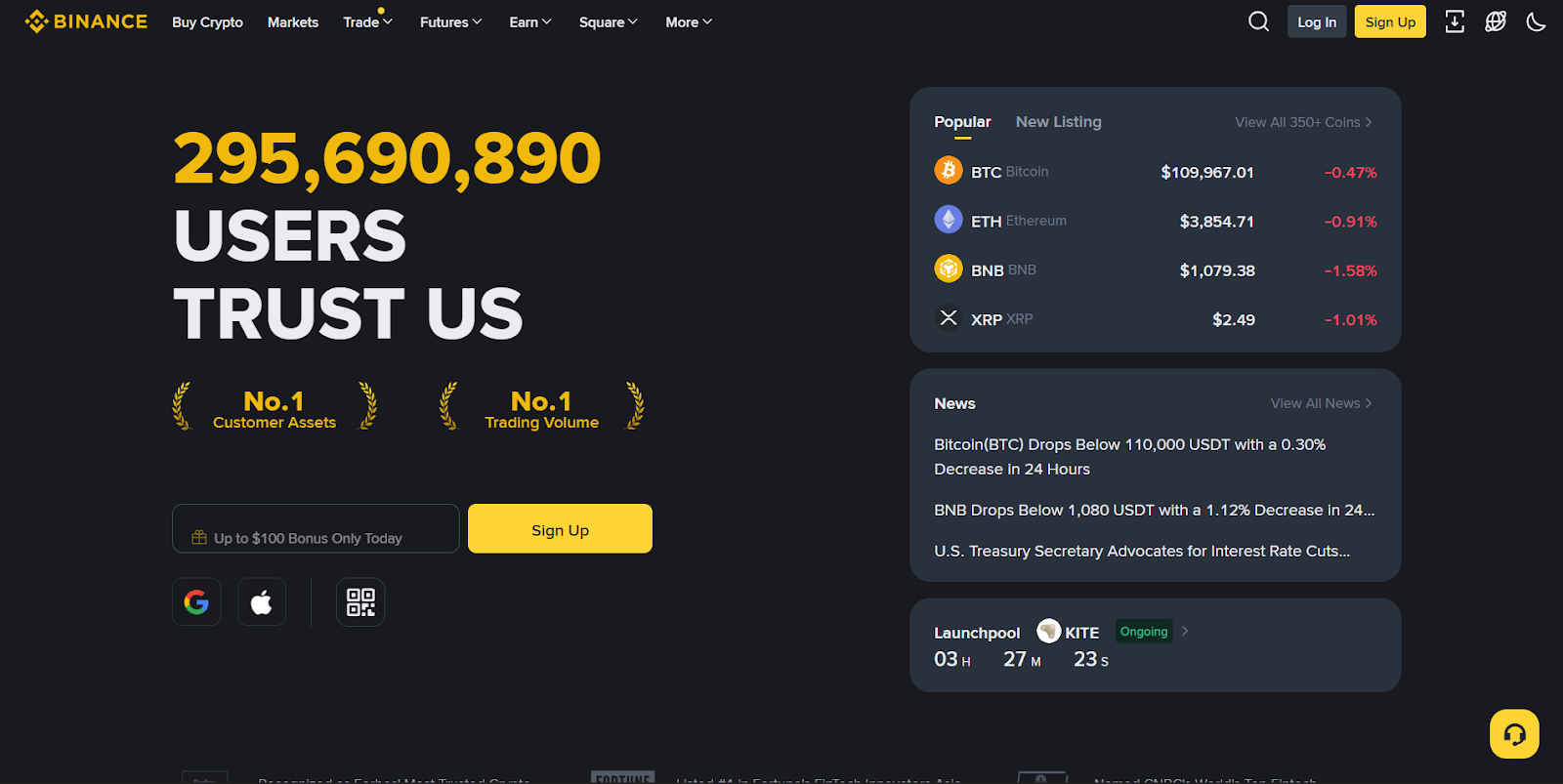Are you torn between KuCoin vs Binance as your go-to cryptocurrency exchange? Binance remains the largest exchange worldwide, processing over $65 billion in daily volume and offering a robust platform for seasoned traders. KuCoin appeals to altcoin enthusiasts with access to over 1,000 cryptocurrencies and flexible trading options.
In this comparison, we’ll break down the key features, fees, security measures, and unique offerings of KuCoin and Binance. Read on for unbiased, in-depth comparisons of Binance and Coinbase.
KuCoin vs Binance: A Glance Comparison
| Criteria | KuCoin | Binance |
| Best For | Traders seeking access to altcoins, trading bots, and early token listings | High-volume traders and those seeking a comprehensive crypto ecosystem |
| Launch Year | 2017 | 2017 |
| Supported Cryptocurrencies | Over 1,000+ assets, including emerging altcoins | 350+ cryptocurrencies |
| Trading Fees | Spot: 0.1% Maker / 0.1% Taker Futures: 0.02% Maker / 0.06% Taker | Spot: 0.1% Maker / 0.1% Taker Futures: 0.02% Maker / 0.05% Taker |
| Leverage | Up to 100x on futures contracts trading | Up to 125x on Binance futures market trading |
| Key Features | Built-in trading bots, vast altcoin selection, and gamified trading | BNB Chain ecosystem, Launchpad & Launchpool, NFTs, and Binance Card |
| Fiat Support | Limited fiat on-ramps, support P2P trading | Extensive fiat deposit options, including bank transfers and Apple Pay |
| Security | Cold storage, 2FA, Proof of Reserves (PoR), insurance fund | Cold storage, 2FA, Secure Asset Fund for Users (SAFU), Proof of Reserves |
| NFT Marketplace | Not dedicated NFT marketplace | Available |
| Mobile App | Feature-rich but may feel complex for new users | Intuitive and easy to navigate, ideal for all user levels |
| Global Reach | Available in 200+ countries | Operates in over 180 countries |
What is KuCoin?


KuCoin is one of the top crypto exchanges, known for its focus on professional traders and its ability to list emerging altcoins faster than most competitors. Launched in 2017, KuCoin has grown to serve over 40 million users across 200+ countries. It offers access to more than 700 altcoins.
If you are a trader looking for hidden gems, KuCoin is a top choice. Many users rely on it as a secondary exchange to platforms like Kraken because of its unmatched selection of altcoins. The platform’s low trading fees, starting at just 0.1%, and advanced features like built-in trading bots make it a favorite among both new and experienced traders.
KuCoin’s journey began long before its official launch. The team started working on blockchain technology in 2011 and spent years perfecting the platform before introducing it to the market. This dedication paid off, as KuCoin quickly gained popularity for its professional-grade tools and innovative programs, including a referral code for new users.
Security is another area where KuCoin excels. The platform uses Proof of Reserves (PoR), two-factor authentication (2FA), and an insurance fund to protect user assets. While KuCoin initially allowed KYC-free trading, it introduced mandatory KYC in July 2023 to comply with global regulations. For traders seeking a robust, secure, and feature-rich platform, KuCoin continues to stand out as a reliable choice in the ever-evolving crypto landscape.
Pros & Cons of KuCoin
| Pros | Cons |
| Access to over 1,000 cryptocurrencies, including hard-to-find altcoins | Limited fiat on-ramps compared to some competitors |
| Low trading fees starting at 0.1% | Customer support can be slow during high-traffic periods |
| Advanced features like trading bots and Futures Brawl | Mandatory KYC introduced in July 2023 |
| Gamified trading options for an engaging experience | Interface may feel overwhelming for beginners |
| Strong security measures, including Proof of Reserves and 2FA | Not available in some regions due to regulatory restrictions |
KuCoin is Best For
- Altcoin hunters are eager to discover and trade newly listed tokens before they appear on other platforms.
- Cost-conscious traders looking to save with low trading fees starting at 0.1%.
- Advanced users who want access to features like trading bots and customizable strategies.
- KuCoin exchange is for traders who value a user-friendly platform with straightforward navigation and tools.
- Security-focused investors prioritizing strong safety measures like Proof of Reserves (PoR) and two-factor authentication.
What is Binance?


Binance was first launched in 2017 and has since grown into the largest global cryptocurrency exchange platform in the crypto space by trading volume. It’s the kind of platform that caters to every type of trader, from beginners dipping their toes into crypto to seasoned pros managing complex portfolios.
With over 350 cryptocurrencies available and $65 billions average daily volume, Binance offers one of the most diverse selections of digital crypto assets. You can explore altcoins, trade Bitcoin, or dive into NFTs. Binance has the tools to help you succeed. The platform’s low fees, starting at 0.1%, make it an attractive choice for frequent traders, and using Binance Coin (BNB) for payments unlocks even greater savings.
For those who prioritize security, Binance account doesn’t disappoint. It employs features like the Secure Asset Fund for Users (SAFU), two-factor authentication, and Proof of Reserves to ensure your assets are protected. While the platform has faced regulatory challenges in some regions, it continues to adapt and comply with local laws, maintaining its reputation as a trusted exchange.
Pros & Cons of Binance
| Pros | Cons |
| Access to over 350 cryptocurrencies and a wide range of trading pairs | Regulatory challenges in certain regions |
| Low trading fees starting at 0.1%, with discounts for BNB users | Customer support can be slow during peak times |
| Advanced features like staking, liquidity farming, and an NFT marketplace | Mandatory KYC for all users |
| High liquidity, ensuring fast and efficient trades | The platform may feel overwhelming for beginners |
| Strong security measures, including SAFU and Proof of Reserves | Not available in some countries due to compliance issues |
Binance is Best For
- Traders who want access to a wide variety of cryptocurrencies, including newly listed tokens.
- High-volume traders who need competitive fees and high liquidity for efficient trades.
- Investors looking for advanced features like staking, liquidity farming, and margin trading to grow their portfolios.
- NFT enthusiasts who want a dedicated marketplace to buy and sell crypto.
- Security-conscious users who value robust safety measures like SAFU and proof of reserves.
KuCoin vs Binance: Trading Features
| Trading Feature | KuCoin | Binance |
| Spot Trading | Available with low fees | Available with low fees, discounts for BNB |
| Futures Trading | Supports up to 100x leverage | Supports up to 125x leverage |
| Margin Trading | Yes, with up to 10x leverage | Yes, with up to 10x leverage |
| Trading Bots | Built-in bots for automated strategies | Not available |
| Liquidity | High liquidity for altcoins | High liquidity across all markets |
| Order Types | Market, limit, stop-limit, and more | Market, limit, stop-limit, OCO, and more |
| Fee Discounts | Discounts for KuCoin Token (KCS) holders | Discounts for Binance Coin (BNB) holders |
| Mobile Trading | Fully-featured mobile app | Fully-featured mobile app |
| API Access | Advanced API for algorithmic trading | Advanced API for algorithmic trading |
| P2P Trading | Yes, with multiple payment options | Yes, with multiple payment options |
KuCoin vs Binance: Platform Products and Services
| Product/Service | KuCoin | Binance |
| Cryptocurrencies Available | Over 1,000 digital assets, including hard-to-find altcoins | Over 350 cryptocurrencies, including major and trending tokens |
| Staking | Available through KuCoin Earn | Available through Binance Earn |
| P2P Trading | Yes, with multiple payment options | Yes, with multiple payment options |
| NFT Marketplace | Not available | Yes, supports trading, staking, and loans for NFTs |
| Launchpad/Launchpool | Yes, for early access to new tokens | Yes, for early access to new tokens |
| Web3 Wallet | Yes, integrated for seamless crypto payments | Yes, integrated for seamless crypto payments |
| Institutional Services | Yes, including wealth management | Yes, including advanced trading tools |
| Mobile App | Fully-featured app for iOS and Android | Fully-featured app for iOS and Android |
| Security Features | Multi-layered security, Proof of Reserves, and compliance certifications | SAFU fund, Proof of Reserves, and advanced security protocols |
| Customer Support | 24/7 support with multilingual options | 24/7 support with multilingual options |
What KuCoin Offers
- KuCoin Earn: A platform for staking and lending, allowing users to earn passive income on their crypto.
- Trading Bots: Automated tools for executing trading strategies without manual intervention.
- Community Incentives: Rewards for KuCoin Token (KCS) holders, including trading fee discounts and daily dividends.
- Global Reach: Serving 40+ million users across 200+ countries with multilingual support.
- Customizable Trading Hub: A user-friendly interface that adapts to both beginners and advanced traders.
What Binance Offers
- Diverse Ecosystem: Includes Binance Academy for free crypto education, Binance Research for market insights, and Binance Charity for social impact.
- Binance Earn: Options for staking, liquidity farming, and earning interest on stablecoins.
- NFT Marketplace: A dedicated platform for trading, staking, and loaning NFTs.
- Launchpad and Labs: Early access to innovative blockchain projects and funding for startups.
- Binance Card: A Visa card enabling crypto-to-fiat currencies conversions for everyday spending.
- Smart Pool for Miners: Optimizes mining income by switching between cryptocurrencies.
- Regulatory Adaptability: Tailored services like Binance.US to comply with local regulations.
Binance vs KuCoin: Fee Structures
| Fee Type | Binance | KuCoin |
| Spot Trading Fees | 0.1% for both makers and takers; discounts available for BNB holders | 0.1% for both makers and takers; discounts available for KCS holders |
| Futures Trading Fees | 0.02% maker / 0.05% taker (with discounts for BNB payments) | 0.02% maker / 0.06% taker (with discounts for KCS payments) |
| Withdrawal Fees | Varies by cryptocurrency; competitive rates | Varies by cryptocurrency; competitive rates |
| Deposit Fees | Free for crypto deposits; fiat deposits may incur third-party fees | Free for crypto deposits; fiat deposits may incur third-party fees |
| Fee Discounts | Up to 25% off trading fees when using Binance Coin (BNB) | Up to 20% off trading fees when using KuCoin Token (KCS) |
| VIP Fee Tiers | Based on 30-day trading volume and BNB holdings, lower fees for higher tiers | Based on 30-day trading volume and KCS holdings, lower fees for higher tiers |
| P2P Trading Fees | No Binance fees for P2P trades | No fees for P2P trades |
Binance vs KuCoin: Coins Supported, Liquidity & Volume
| Category | Binance | KuCoin |
| Number of Cryptocurrencies | Over 350 cryptocurrencies, including major and trending tokens | Over 1,000 cryptocurrencies, including niche and newly listed tokens |
| Liquidity | High liquidity across all markets, ensuring fast and efficient trades | High liquidity for altcoins, slightly lower for major tokens |
| Fiat Support | Supports 27+ fiat digital currencies for deposits and withdrawals | Limited fiat support; primarily crypto-to-crypto trading |
| New Listings | Regularly adds trending and innovative tokens | Focuses on early access to new and niche tokens |
KuCoin vs Binance: Security Comparison
When it comes to security, both KuCoin and Binance implement robust measures to protect user crypto assets and data. KuCoin employs a multi-layered security framework that includes advanced encryption, two-factor authentication (2FA), and continuous monitoring for suspicious activities. Additionally, KuCoin holds compliance certifications such as PCI DSS and ISO/IEC 27001, ensuring adherence to global security standards. The platform also runs a bug bounty program to identify and address vulnerabilities proactively, further safeguarding user funds.
Binance exchange, on the other hand, is known for its Secure Asset Fund for Users (SAFU), which acts as an emergency reserve to cover losses in rare security breaches. The platform also uses Binance advanced security protocols, including AI-driven risk management systems and cold wallet storage for the majority of user funds. Binance’s Proof of Reserves adds an extra layer of transparency, allowing users to verify the platform’s solvency. Both exchanges prioritize user protection, but Binance’s additional focus on fund recovery and transparency gives it a slight edge in terms of comprehensive security measures.
KuCoin Security Measures
- Multi-layered security framework
- Advanced encryption protocols
- Two-factor authentication (2FA)
- Continuous monitoring for suspicious activities
- PCI DSS and ISO/IEC 27001 compliance
- Bug bounty program
Binance Security Measures
- Secure Asset Fund for Users (SAFU)
- AI-driven risk management systems
- Cold wallet storage for majority of funds
- Two-factor authentication (2FA)
- Proof of Reserves for transparency
- Advanced security protocols
KuCoin vs Binance: Affiliate & Referral Programs
| Feature | KuCoin | Binance |
| Referral Rewards | Up to 40% commission on trading fees from referrals | Up to 50% commission on trading fees from referrals |
| Affiliate Program | Yes, with tiered commission structure based on performance | Yes, with high commission rates and exclusive benefits for top affiliates |
| Eligibility | Open to all users; higher rewards for KuCoin Token (KCS) holders | Open to all users; higher rewards for Binance Coin (BNB) holders |
| Payout Frequency | Weekly payouts in cryptocurrency | Real-time payouts in cryptocurrency |
| Additional Benefits | Exclusive bonuses for high-performing affiliates | Access to marketing tools and exclusive affiliate events |
Binance vs KuCoin: User Experience
Binance and KuCoin cater to a wide range of users, from beginners to experienced traders, but their approaches to user experience differ. Binance offers a highly polished and feature-rich platform with a clean interface that is easy to navigate. Its mobile app mirrors the desktop experience, providing seamless access to trading, staking, and other features. New users can sign up with a Binance referral code to get bonuses and check out the platform’s tools. Binance also offers multiple trading modes, including a simplified version for beginners and an advanced mode for professional Binance traders. The platform’s extensive educational resources, such as Binance Academy, further enhance the user experience by helping users understand complex trading concepts.
KuCoin, on the other hand, focuses on customization and accessibility. Its trading hub allows users to drag, resize, and hide modules, tailoring the interface to their preferences. KuCoin’s mobile app is equally robust, offering features like automated trading bots and real-time market updates. While KuCoin’s interface is user-friendly, it may feel slightly overwhelming for beginners due to the sheer number of features and options available. However, its focus on niche altcoins and early access to new tokens makes it a favorite among seasoned traders. Overall, Binance excels in providing a streamlined and educational experience, while KuCoin stands out for its flexibility and focus on altcoin trading.
Binance vs KuCoin: Customer Support
Customer support is a critical aspect of any trading platform, and both Binance and KuCoin have made significant efforts to assist their users. Binance offers 24/7 multilingual customer support through live chat, email, and a comprehensive help center. The platform also provides a detailed FAQ section and troubleshooting guides, making it easier for users to resolve common issues independently. Binance’s support team is known for its quick response times.
KuCoin exchange also offers 24/7 customer support, but its primary mode of assistance is through live chat and email. While the platform provides a help center with FAQs and guides, it lacks the extensive educational resources that Binance offers. KuCoin’s support team is responsive, but some users have reported delays in resolving complex issues. On the positive side, KuCoin has a strong community presence, with active forums and social media channels where users can seek advice and share experiences. Both platforms prioritize user support, but Binance’s broader range of resources and faster response times give it an edge in this category.
Conclusion
Binance and KuCoin are both leading cryptocurrency exchanges, each excelling in different areas to cater to diverse user needs. Binance stands out with its extensive ecosystem, offering over 350 cryptocurrencies, high liquidity, and a user-friendly interface suitable for both beginners and advanced traders. Its robust security measures, including the Secure Asset Fund for Users (SAFU) and Proof of Reserves, provide users with confidence in the platform’s reliability. Additionally, Binance’s comprehensive educational resources and faster customer support response times make it a preferred choice for those seeking a seamless and secure trading experience.
KuCoin appeals to traders looking for access to a broader range of cryptocurrencies, with over 1,000 tokens available, including niche and newly listed coins. Its customizable trading hub and advanced tools like trading bots make it a favorite among experienced traders. While its security measures and customer support are commendable, KuCoin’s focus on altcoins and early access to new tokens sets it apart. However, the platform may feel overwhelming for beginners due to its extensive features and slightly less streamlined interface.
From an objective standpoint, Binance is better suited for users prioritizing liquidity, security, and a polished user experience, while KuCoin is ideal for those seeking flexibility, altcoin diversity, and advanced trading tools. The choice ultimately depends on individual trading goals and preferences. Both platforms are reliable and innovative, making them strong contenders in the cryptocurrency exchange market.
FAQs
Is KuCoin a trusted cryptocurrency exchange?
KuCoin is a reliable crypto exchange platform that has strong security measures and global compliance certifications. Since its launch in 2017, it has built a solid reputation by serving millions of users around the world with dependable service and clear operations.
What exchange is better than Binance?
The best crypto exchange compared to Binance depends on your trading needs. Binance stands out for its liquidity and security. On the other hand, KuCoin provides a wider range of altcoin choices. Traders who focus on low fees or specific tokens might like KuCoin more, while those looking for stability and a larger ecosystem generally choose Binance.
Which exchange has lower fees: Binance fees vs KuCoin fees?
Between Binance and KuCoin, both have 0.1% trading fees, but Binance offers discounts with BNB, and KuCoin offers discounts with KCS.
Which exchange is more beginner-friendly: KuCoin or Binance?
Between KuCoin and Binance, Binance is friendlier for beginners because of its simple interface and helpful resources. It also provides a Lite mode for new users, which makes it easier to find trading features without feeling overwhelmed.
Which exchange is more secure: KuCoin vs Binance?
KuCoin and Binance are both some of the most secure exchanges, but Binance has an edge with its Secure Asset Fund for Users (SAFU) and Proof of Reserves. KuCoin uses multi-layer encryption and a risk control system. However, Binance has a larger security setup and more transparency measures.
What are the deposit and withdrawal options on KuCoin and Binance?
KuCoin focuses on crypto-to-crypto transactions. In contrast, Binance supports more options for fiat deposits and withdrawals. Binance users can fund their accounts through bank transfers, credit cards, or third-party payment providers. This gives them more flexibility when moving funds.








![[Op-Ed] Ann Cuisia: How the CADENA Act Finally Gets the Point](https://newsaicrypto.com/wp-content/uploads/2025/11/Op-Ed-Ann-Cuisia-1-100x75.png)

